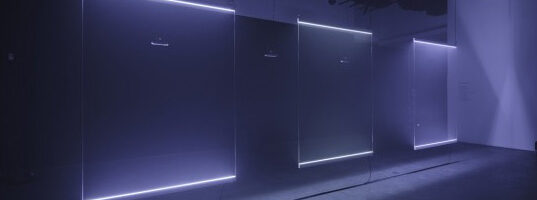Atmosphere
January 19-February 9, 2011
Main Gallery/Black Box
LabXmodal: Chris Salter + Marije Baalman, Elio Bidinost, Shannon Collis, Fernando Leppe,
Harry Smoak, Robert Tomes, Matthieu Tremblay, Tobias Ziegler
Planes of light appearing at the verge of seeing and a completely darkened space in which vision, hearing and touch are probed at the thresholds of perception are two of the experiences awaiting viewers in Chris Salter’s “Atmosphere,” an exhibition bringing together several sensorially-based, room-sized audio-visual-tactile installations. An artist, researcher and professor in the Fine Arts at Concordia whose large scale immersive environment Air XY in collaboration with designer Erik Adigard was commissioned for the curated show in the 2008 Venice architecture Biennale, Salter is interested in the ways in which new technologies amplify and transform the thresholds of human sensation and perception.
Atmosphere is a total sensory environment combining coloured light, sound, infrared heat and haze. Over a 20 minute cycle, sudden bursts of light, sound and heat transform the main FOFA gallery into a synesthetic space fluctuating between dense overload and contemplative reflection. Exploring what architecture critic Mark Wigley calls “an architecture of atmosphere,” a sensuous climate of ephemeral yet, tangibly felt effects envelop visitors, probing the ways in which the just perceivable opens up our experience of noise and order, sense and sensation.
Simultaneously, the FOFA Gallery’s Black Box will feature an experimental version of Salter’s most recent Just Noticeable Difference (JND) installation which has been touring Europe. JND is a sensory environment for one person at a time lying in total darkness. The installation is based on Gustav Fechner’s concept of the Just Noticeable Difference: the ability to perceptually detect the smallest changes in sensory stimuli. Combining near darkness with extraordinary low levels of vibration, light and sound, visitors enter the pitch dark black box and lie down on a raised, body length surface. Once inside, visitors experience a “composition of touch, light and sound”; an extraordinarily wide range of visual, auditory and tactile sensations that challenge how we perceive the smallest degrees of change in sensory stimuli over different levels of intensities.
Atmosphere explores four conceptual/technological areas of research: cross modal sensory phenomena, perceptual thresholds, questions about the dissolution of self-hood inside sensory reduction environments and ecological concepts of perception. It is funded by SSHRC, CALQ, Concordia and Hexagram.


